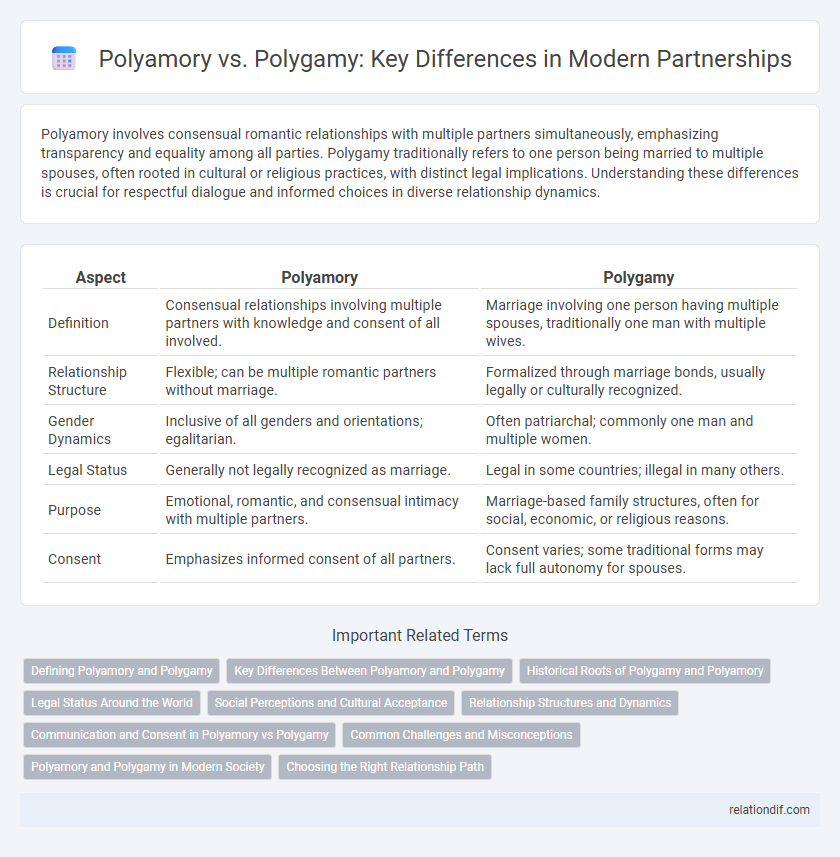Polyamory involves consensual romantic relationships with multiple partners simultaneously, emphasizing transparency and equality among all parties. Polygamy traditionally refers to one person being married to multiple spouses, often rooted in cultural or religious practices, with distinct legal implications. Understanding these differences is crucial for respectful dialogue and informed choices in diverse relationship dynamics.
Table of Comparison
| Aspect | Polyamory | Polygamy |
|---|---|---|
| Definition | Consensual relationships involving multiple partners with knowledge and consent of all involved. | Marriage involving one person having multiple spouses, traditionally one man with multiple wives. |
| Relationship Structure | Flexible; can be multiple romantic partners without marriage. | Formalized through marriage bonds, usually legally or culturally recognized. |
| Gender Dynamics | Inclusive of all genders and orientations; egalitarian. | Often patriarchal; commonly one man and multiple women. |
| Legal Status | Generally not legally recognized as marriage. | Legal in some countries; illegal in many others. |
| Purpose | Emotional, romantic, and consensual intimacy with multiple partners. | Marriage-based family structures, often for social, economic, or religious reasons. |
| Consent | Emphasizes informed consent of all partners. | Consent varies; some traditional forms may lack full autonomy for spouses. |
Defining Polyamory and Polygamy
Polyamory involves engaging in multiple consensual, emotionally intimate relationships simultaneously with the knowledge and consent of all parties, prioritizing transparency and equal emotional connection. Polygamy specifically refers to a marital structure where one individual is legally married to multiple spouses, often within cultural or religious contexts, usually without the equal emotional involvement characteristic of polyamory. Understanding these definitions highlights key distinctions in relationship dynamics, legal recognition, and societal acceptance.
Key Differences Between Polyamory and Polygamy
Polyamory involves consensual, non-exclusive relationships where individuals have multiple romantic partners simultaneously, emphasizing emotional connections and transparency. Polygamy is a legally or culturally recognized marriage system allowing one person to have multiple spouses, often structured as polygyny or polyandry. Key differences include legal status, social acceptance, and the emphasis on emotional bonds versus marital commitment.
Historical Roots of Polygamy and Polyamory
Polygamy has deep historical roots, with documented practices spanning ancient civilizations such as Mesopotamia, Egypt, and various African societies, often linked to social, economic, and familial alliances. Polyamory, by contrast, emerged primarily in the late 20th century as part of the broader sexual revolution, emphasizing ethical, consensual multiple relationships without traditional religious or legal frameworks. The historical distinction highlights polygamy's structured, often patriarchal nature versus polyamory's modern emphasis on egalitarian and open partnerships.
Legal Status Around the World
Polyamory remains largely unrecognized by legal systems globally, with most countries lacking specific laws to address multiple consensual romantic relationships, whereas polygamy is legally sanctioned in several nations, primarily within parts of Africa, the Middle East, and South Asia based on cultural or religious frameworks. Legal challenges surrounding polyamory often involve custody, taxation, and healthcare benefits due to the absence of formal recognition. In contrast, polygamous unions typically receive official acknowledgment, granting spouses defined legal rights and obligations under national family laws.
Social Perceptions and Cultural Acceptance
Polyamory and polygamy differ significantly in social perceptions and cultural acceptance, with polyamory gaining broader recognition in contemporary Western societies as a form of consensual non-monogamy emphasizing emotional intimacy. Polygamy, often rooted in religious or traditional practices, faces legal restrictions and stigma in many countries, especially in the West, due to associations with patriarchy and inequality. The evolving discourse around polyamory challenges conventional norms, fostering more inclusive attitudes, whereas polygamy remains controversial and less socially accepted outside specific cultural contexts.
Relationship Structures and Dynamics
Polyamory involves consensual, ethical non-monogamous relationships where all partners engage in multiple emotional and romantic connections, emphasizing communication and mutual respect. Polygamy typically refers to a marriage system where one person has multiple spouses, often legally or culturally sanctioned, with hierarchical roles frequently observed. The dynamics in polyamory prioritize egalitarian interactions among partners, while polygamy's structure may involve distinct social and legal statuses affecting relational power balances.
Communication and Consent in Polyamory vs Polygamy
Communication and consent are foundational to polyamory, emphasizing ongoing dialogue and mutual agreement among all partners to navigate complex emotional dynamics. In polygamy, consent is often structured within traditional or cultural frameworks that may prioritize hierarchical roles, sometimes limiting open communication. Polyamory's emphasis on transparency and negotiated boundaries contrasts with polygamy's generally prescribed relational roles, highlighting different approaches to partnership ethics and relational autonomy.
Common Challenges and Misconceptions
Polyamory and polygamy often face common challenges such as societal stigma, legal recognition issues, and navigating emotional dynamics within multiple-partner relationships. Misconceptions include the inaccurate belief that polyamory and polygamy are synonymous, whereas polyamory emphasizes ethical, consensual relationships without necessarily involving marriage, while polygamy specifically refers to one individual married to multiple spouses. Both relationship models require clear communication, trust, and boundary-setting to manage jealousy and maintain harmony among partners.
Polyamory and Polygamy in Modern Society
Polyamory and polygamy represent distinct forms of consensual non-monogamous partnerships, with polyamory emphasizing multiple emotional and romantic relationships simultaneously, while polygamy traditionally involves one person married to multiple spouses, often rooted in cultural or religious practices. In modern society, polyamory gains visibility through advocacy for relationship autonomy and challenges to mononormative norms, whereas polygamy remains legally restricted in many countries but persists in specific communities. Understanding these frameworks highlights evolving social attitudes toward diverse family structures and the legal, emotional, and ethical considerations shaping contemporary partnership models.
Choosing the Right Relationship Path
Choosing the right relationship path involves understanding the fundamental differences between polyamory and polygamy, where polyamory emphasizes consensual, multiple romantic relationships without legal or religious bindings, and polygamy involves marriage to multiple spouses, often rooted in cultural or religious traditions. Individuals seeking a suitable partnership style should evaluate personal values, emotional needs, and legal considerations unique to each arrangement. Clarity on communication, consent, and commitment levels is essential for thriving relationships in both polyamorous and polygamous contexts.
polyamory vs polygamy Infographic

 relationdif.com
relationdif.com